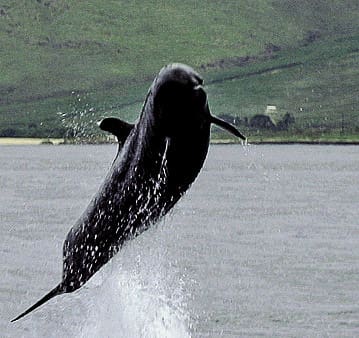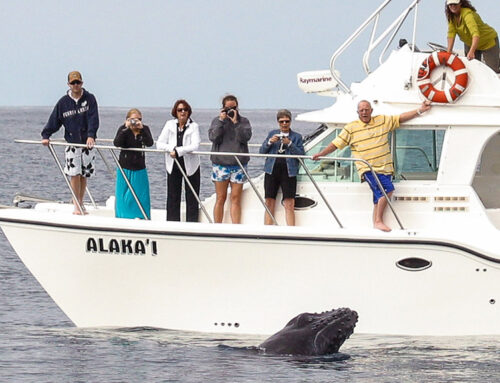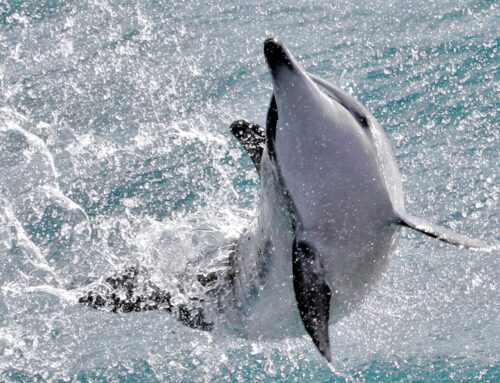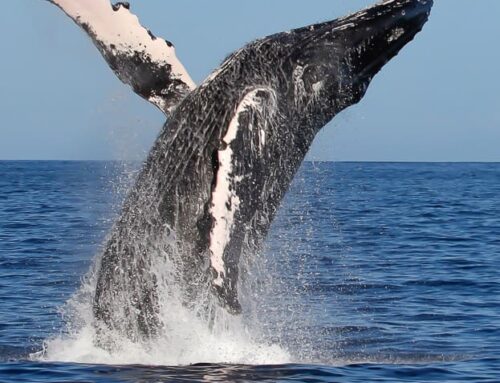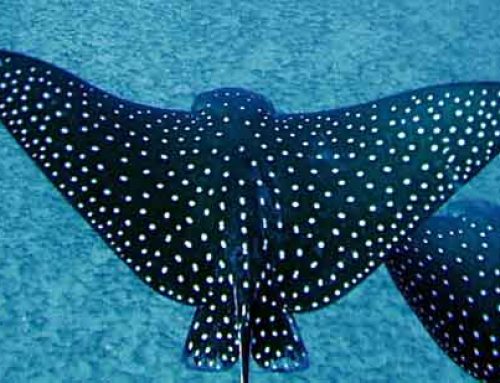Hawaiian False Killer Whales
Scientific Name: Pseudorca crassidens
Of the 18 species of toothed whales found in Hawaii, the Hawaiian false killer whales are the most at risk. Federally listed as Endangered in December 2012, False killer whales have the lowest known abundance , and are divided into three discrete populations (an open-ocean population, a Northwestern Hawaiian Islands population and the insular population around the main Hawaiian Islands), is slow to reproduce, is known to be threatened by a number of different human activities, and is very high on the food web.
False killer whales can be identified by their small conical beak-lacking heads. Males have more of an overhanging jaw then females do.
Their flippers have a distinctive hump or bulge in the middle of the front edge. False killer whales have dark coloration except for some lighter patches near the throat and middle chest. Their body shape is rather slender. The dorsal fin, although variable in shape, tends to be falcate and slender, and is generally rounded at the tip (compare to a pointy pilot whale fin).
False killer whales share a very similar skull and other traits with true Orca (uncommon, long-lived, slow to mature, calve once every 6-7 years). However, they are quite distinct from them. For instance, though both are top predators, false killer’s rarely attack mammalian prey. And while Orca are quite popular, most folks have never heard of the pseudorca – false killer whale, or its plight.
Publications from our working group (T. Cullins) on Hawaiian False Killer Whales
- Mahaffy, S.D., R.W. Baird, A.E. Harnish, T. Cullins, S.H. Stack, J.J. Currie, A.L. Bradford, D.R. Salden, and K.K. Martien. 2023. Identifying Social Clusters of Endangered Main Hawaiian Islands False Killer Whales. Endangered Species Research 51:249-268 doi: 10.3354/esr01258
- Bradford, A., R. Baird, S. Mahaffy, A. Gorgone, D. McSweeney, T. Cullins, D. Webster, A. Zerbini. 2018. Abundance estimates for management of endangered false killer whales in the main Hawaiian Islands. Endangered Species Research 36:297-313
- Mahaffy S., Baird R., Gorgone A, Cullins T., McSweeney D., Webster D. 2017 “Group dynamics of the endangered insular population of false killer whales in Hawai‘i.” Poster presented at the 22nd Biennial Conference on the Biology of Marine Mammals.
- Baird, R.W., S.D. Mahaffy, A.M. Gorgone, K.A. Beach, T. Cullins, D.J. McSweeney, D.S. Verbeck and D.L. Webster. 2017. Updated evidence of interactions between false killer whales and fisheries around the main Hawaiian Islands: assessment of mouthline and dorsal fin injuries. Document PSRG-2017-16 submitted to the Pacific Scientific Review Group.
- Baird, R.W., S.D. Mahaffy, A.M. Gorgone, T. Cullins, D.J. McSweeney, E.M. Oleson, A.L. Bradford, J. Barlow and D.L. Webster. 2014. False killer whales and fisheries interactions in Hawaiian waters: evidence for sex bias and variation among populations and social groups. Marine Mammal Science doi: 10.1111/mms.12177. Download PDF copy

False killer whales are no typical marine mammal. They are fast, able to swim from Kauai to the Big Island in four days. They create long-lasting friendships and can stay with partners for more than 20 years. They have a unique way of feeding, which may reveal how they communicate trust: When a false killer whale catches a fish, it passes it to every individual in its group—imagine a game of Frisbee—who eventually returns the fish intact.
In Hawaii, false killer whales feed primarily on mahi mahi, tuna, ono, mongchong and swordfish – as do the longline fisheries using 3/8-inch nylon rope thousands of feet long. Attached every three feet is a short line with a hook to which bait is attached. The longline is let out behind a boat and anchored to the bottom. To increase success of finding prey, The false killer whales travel in a band that can be several miles wide. Likewise longliner fisheries can have miles of line and thousands of hooks set out, from just one boat.
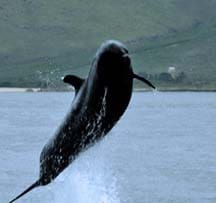
There are three populations of Hawaiian False Killer Whales. The “insular” population, found nearer the islands and of which are the only known genetically isolated population. This population has been decimated over the past thirty years – the current population is estimated at only 123 individuals. The insular population also appears to be split into four clusters or subgroups. Clusters 2 and 4 are very discrete and more rarely seen. While Cluster 1 was seen off all islands, Cluster 2 (smallest group) was seen primarily off Hawai‘i Island, Cluster 3 was seen primarily off O‘ahu and Hawai‘i Island, and Cluster 4 (considered an offshoot of Cluster 1) was seen primarily off Maui Nui.
- Mahaffy, S.D., R.W. Baird, A.E. Harnish, T. Cullins, S.H. Stack, J.J. Currie, A.L. Bradford, D.R. Salden, and K.K. Martien. 2023. Identifying Social Clusters of Endangered Main Hawaiian Islands False Killer Whales. Endangered Species Research 51:249-268 doi: 10.3354/esr01258
Participate in a Hawaiian False Killer Whale Expedition with Wild Side
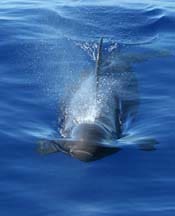
An outgoing, large dolphin that exhibits strong social bonds, false killer whales can belong to larger groups of up to 40 individuals. They have often been observed sharing food and supporting injured members of a pod.
These intriguing marine mammals have a breeding season that lasts several months. Females may not become reproductively mature until around 10 years of age. Males may not reach maturity until about 18! Life spans are estimated at 58 years for males and 62 years for females, who go through menopause.
False killer whales are bycatch of, or have interactions with a number of fisheries. They have been recorded interacting with Hawaii’s longline and bottomfish fisheries off the Northwestern Hawaiian Islands. These types of interactions often result in injury such as dorsal fin disfigurement or death. Dorsal fin disfigurement may affect reproduction and survival as dorsal fins help control body temperature.
- Baird, R.W., S.D. Mahaffy, A.M. Gorgone, K.A. Beach, T. Cullins, D.J. McSweeney, D.S. Verbeck and D.L. Webster. 2017. Updated evidence of interactions between false killer whales and fisheries around the main Hawaiian Islands: assessment of mouthline and dorsal fin injuries. Document PSRG-2017-16 submitted to the Pacific Scientific Review Group. Download PDF copy
Wild Side’s wildlife tours focus on education and conservation so that an interactive relationship can be maintained in the best interest of both humans and dolphins. We strive to foster admiration and deep respect for these wonder-full marine mammals.

